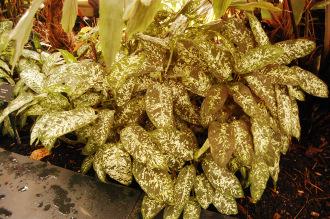
Dieffenbachia maculata (16/01/2016, Kew Gardens, London)
Position: Indirect bright to medium light
Flowering period: All year round
Soil: Moist, well drained
Eventual Height: 1.5m
Eventual Spread: 60cm
Hardiness: 10a 10b, 11, 12, 13
Family: Araceae
Dieffenbachia maculata is an evergreen shrub with an upright habit. Its dark green leaves are spotted with yellow variegation, ovate with entire margins, up to 30cm long and 15cm across. Its cream flowers are spathes and are rarely seen in cultivation.
Dieffenbachia maculata, commonly known as Dumb Cane or Tuft Root, is native to the tropical regions of Central and South America. In its native habitat it grows as a tropical woodland understory plant. Dieffenbachia maculata is synonymous with Dieffenbachia seguine.
The etymological root of the binomial name Dieffenbachia is named after Joseph Dieffenbach (1796–1863), the head gardener of the Botanical Gardens in Vienna, Austria. Maculata is derived from the Latin macula meaning ‘spot’.
The landscape architect may find Dieffenbachia maculata useful as an attractive foliage houseplant. Its should be noted this plant is poisonious.

Dieffenbachia maculata Leaf (16/01/2016, Kew Gardens, London)
Ecologically, Dieffenbachia maculata is of little value to UK wildlife.
Dieffenbachia maculata prefers moist, humus rich, well-drained soils. It tolerates most pH of soil.
When maintaining Dieffenbachia maculata as a houseplant its soil should be watered regularly. Watering should be reduced during the winter months. Its preferred active growing temperature rages from between 18ºc to 29ºc, it will tolerate a temperature as low as 10ºc. Feeding with weak fertiliser solution should be carried out once a month during the growing season. This plant may be sprayed with water to improve its humidity. Aphids and Mealy Bugs, Scale Insects and Red Spider Mites may attack this plant. Regular pruning of old growth or dead will encourage a tidier plant.

Landscape Architecture

